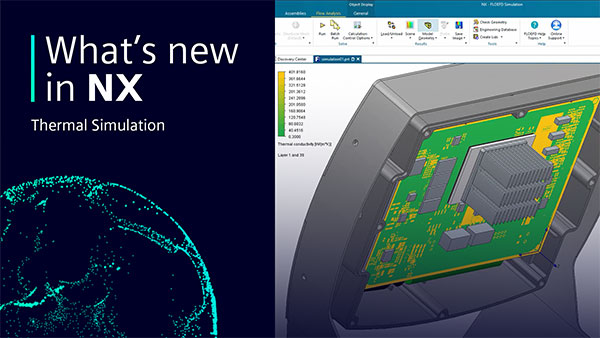
In a scenario of thermal simulation, Simcenter FLOEFD is embedded directly into NX. Image courtesy of Siemens.
Latest News
October 27, 2022
Siemens NX for thermal simulation offers a bevy of new features.
Frontload All CFD Simulation Inside of NX
One notable new feature within NX is the power to embed other software into your workspace. In a scenario of thermal simulation, Simcenter FLOEFD is embedded directly into NX. This means that you do not have to learn new software and can continue working in an environment native to you. Another addition to this software is that by embedding Simcenter FLOEFD into NX, the changes you make are automatically detected and synchronized to your design.
Use Component Control to Select Geometry
The next step is to exclude any geometry that would be replaced later on. For this, it is necessary to use the component control to tell Simcenter FLOEFD to ignore the pre-determined geometry. In this specific example, there is no need to include the mechanical computer-aided design (MCAD) printed circuit board (PCB). The MCAD PCB will be replaced later with the thermal representation that will be created.
Creating a Thermal Representation With EDA Bridge
Now that you have selected the components that we need, consider the PCB in this example. This is where Simcenter FLOEFD’s built in EDA (electronic design automation) Bridge tool comes into play. EDA Bridge reads the PCB design file directly and can export it into a thermal model with the aligning material properties.
Use Smart PCB Technology
- Works by modeling the PCB as a huge network assembly
- Enables detailed copper distribution
- Minimal additional computational overhead
Cloning for Comparison
After your thermal representation of the PCB has been completed as a sub-assembly, you can now use the “Add from Components” feature to re-enter all the inputs back into the original model. Along with the new PCB, you can also select and replace the component model for the processor with a more detailed model to better represent the thermal conditions expected.
This detailed model of processor could be imported, or a new model can be created using Simcenter FLOEFD’s built-in Package Creator.
Clone the Model and Solve
Once the PCB sub-assembly is reviewed and closed, return to the main simulation model. Before running the simulation, create a second simulation to compare how the modified covers with cooling holes perform versus the standard rear cover. Before solving the projects, it's critical to tell Simcenter FLOEFD to ignore your original model and include the modified model that you are experimenting with. At this point you can solve both projects.
Reviewing Thermal Simulation Results
Once both simulations have finished, you can review the results. In most cases, it should be clear the impact the experimental model has on the thermal dynamics versus the stand model. By sing thermal simulations, you can efficiently find the impact that two contrasting designs can have on your model without ever leaving NX.
Sources: Press materials received from the company and additional information gleaned from the company’s website.
More Siemens Digital Industries Software Coverage
Subscribe to our FREE magazine, FREE email newsletters or both!
Latest News
About the Author
DE’s editors contribute news and new product announcements to Digital Engineering.
Press releases may be sent to them via [email protected].





